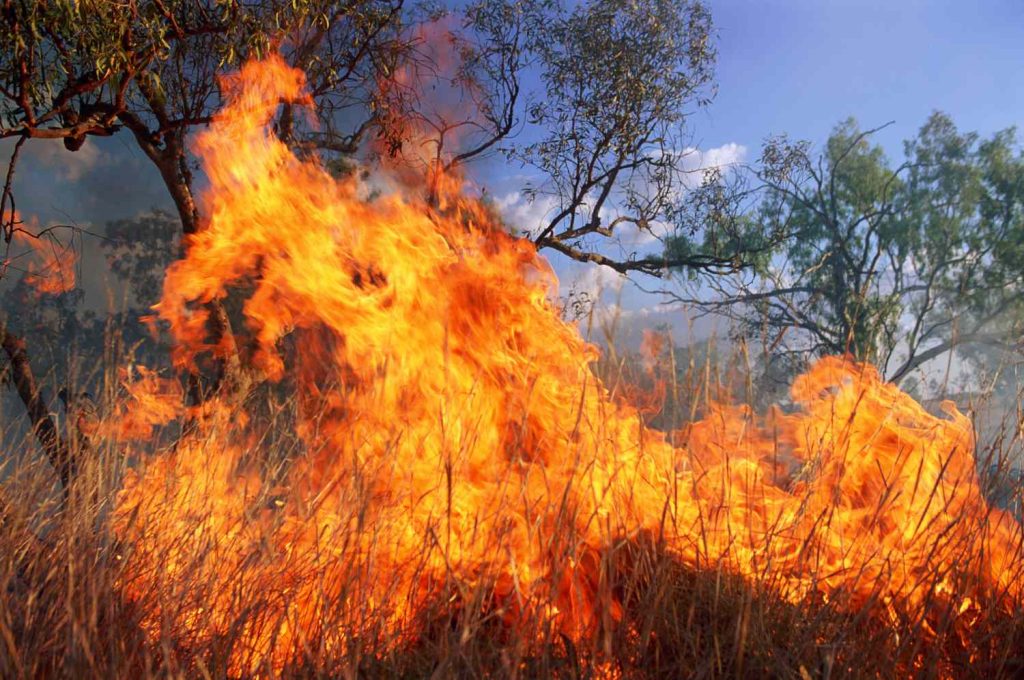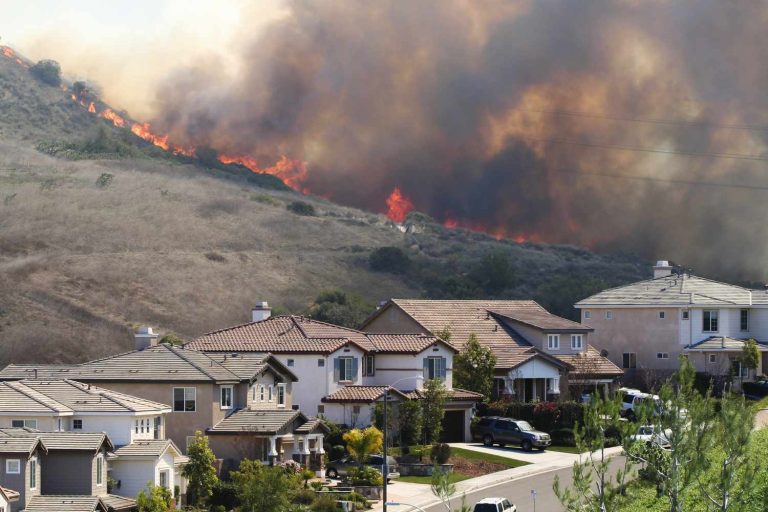Every so often, on an otherwise pleasant day with a gentle breeze, you might see a weather alert pop up on your phone or TV. Don’t dismiss it—it’s probably a fire weather warning. That means the current conditions are ripe for wildfires to ignite and spread.
Fire weather can happen year-round, but it’s most common in late summer and fall when the air turns drier and natural fuels like fallen leaves and dormant vegetation become more abundant. While fire weather is a global phenomenon, it’s hazardous in wildfire-prone regions such as the western United States, Australia, Africa, and the Amazon.
Weather Conditions That Fuel Wildfires
For a fire to ignite and spread, it needs three essential elements: heat, oxygen, and a dry fuel source. Certain weather conditions combine to provide this perfect storm, dramatically increasing the risk of wildfires.
High Temperatures
Hot weather accelerates evaporation, pulling moisture from vegetation like grass, shrubs, trees, fallen leaves, and pine needles — all of which serve as tinder for wildfires. As fuels dry out under intense sun and heat, they become far more flammable, requiring less energy to reach ignition. The hotter it gets, the easier it is for fires to spark and spread.
Limited Precipitation
Rain and snow help moisten vegetation and other fuels, making it harder for fires to ignite. However, when there’s little to no precipitation—or during prolonged drought conditions—these fuels dry out, becoming much more flammable and susceptible to combustion.
Reduced Soil Moisture
Soil moisture, or the water content held in the soil, serves as a reliable indicator of fuel moisture—the hydration level of living plants. When soil moisture levels are low, nearby vegetation is likely to be dry and stressed, making it more prone to burning. In fact, a study focused on the Southern Great Plains found that soil moisture has a more substantial influence on wildfire size than even high temperatures or limited rainfall.
Low Relative Humidity
When relative humidity—the amount of moisture in the air—is low, vegetation and other fuels dry out, making them much easier to ignite and burn.
Gusty Winds
If a fire starts, strong winds can make it much worse. Winds feed the fire with extra oxygen, causing it to burn faster. They also speed up evaporation, drying out fuels even more. Additionally, gusty winds help the fire spread by pushing flames forward and carrying embers ahead, potentially sparking new fires.
When monitoring weather conditions, watch for a combination of low humidity and strong, gusty winds, especially following the passage of a dry cold front (a cold front bringing dry air). Critical fire weather often coincides with high atmospheric pressure aloft, which creates “heat domes.” These heat domes bring clear skies, sinking dry air, and above-average temperatures—perfect conditions for fire danger during warmer months.

Fire Weather Watches and Warnings
Since controlling wildfires depends heavily on weather conditions, NOAA’s National Weather Service (NWS) collaborates closely with land management agencies to track weather patterns that could fuel fires, when multiple fire-related weather factors occur together—especially alongside dry vegetation—the NWS issues either a fire weather watch or a red flag warning to alert communities and responders.
Fire Weather Watch
A fire weather watch is announced when conditions that meet red flag criteria might develop within the next 24 to 72 hours. This advance notice helps firefighters and the public prepare for an increased risk of wildfire.
What Are Red Flag Criteria?
Red flag criteria are specific thresholds for wind speed, humidity, and fuel dryness that indicate heightened fire danger. These thresholds vary regionally, depending on factors like local vegetation, landscape, and drought severity. Generally, red flag criteria include:
- Winds of 15 mph or more (measured 20 feet above the ground)
- Relative humidity below 25% during the afternoon
- 10-hour fuel moisture at or below 10% (this measures how dry grasses and leaves are, with “10-hour” referring to how quickly these fuels respond to moisture changes)
Red Flag Warning
A red flag warning means red flag criteria are currently being met or will be within the next 12 to 24 hours. Fires starting under these conditions are expected to spread rapidly and be very difficult to control. During red flag warnings, burn bans are typically enforced to reduce ignition risks.
The Impact of Climate Change on Fire Weather
If you’ve noticed more red flag warnings in recent years, climate change is a significant reason why. Rising global temperatures have extended fire weather seasons—the periods each year when conditions are favorable for wildfires.
A study published in Nature Communications found that from 1979 to 2013, fire weather seasons grew by an average of 19% across about 25% of Earth’s vegetated land. In the western United States, these seasons have lengthened by about eight days.
The study also showed a 53% increase globally in unusually long fire weather seasons, linking this trend directly to climate change.
Focusing on California, research indicates that since the 1980s, warmer autumn temperatures and reduced rainfall have raised fire weather risk by about 20%. If these trends continue, California could experience a 25% increase in autumn fire weather days by 2100.
FAQ’s
What exactly is fire weather?
Fire weather refers to specific weather conditions—like high temperatures, low humidity, strong winds, and dry fuels—that increase the risk of wildfires igniting and spreading rapidly.
When is fire weather most common?
Fire weather can occur year-round but is most common in late summer and fall, when vegetation dries out and temperatures stay high.
What does a red flag warning mean?
A red flag warning indicates that fire weather conditions are currently met or imminent, signaling a high risk for fast-spreading wildfires and often triggering burn bans.
How do wind and humidity affect wildfires?
Strong winds provide oxygen and help fires spread quickly, while low humidity dries out vegetation, making it easier for fires to start and grow.
How is climate change impacting fire weather?
Climate change is lengthening fire weather seasons and increasing the frequency and intensity of red flag warnings due to warmer temperatures and drier conditions globally.
Conclusion
Fire weather alerts are vital warnings signaling increased wildfire risk caused by a combination of dry fuels, hot temperatures, low humidity, and gusty winds. Understanding these conditions helps communities prepare and respond effectively. With climate change extending fire seasons and intensifying these factors, staying informed and heeding fire weather watches and red flag warnings is more critical than ever to protect lives, property, and ecosystems. Vigilance and proactive measures remain key to reducing wildfire impacts.


